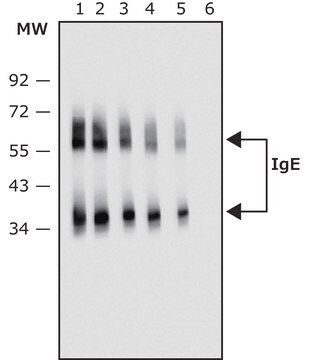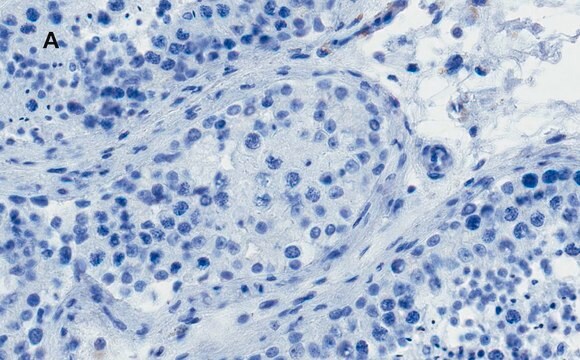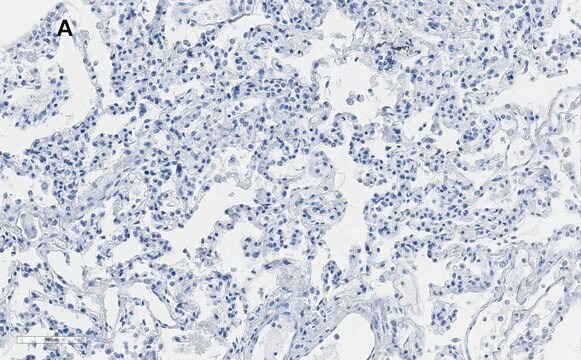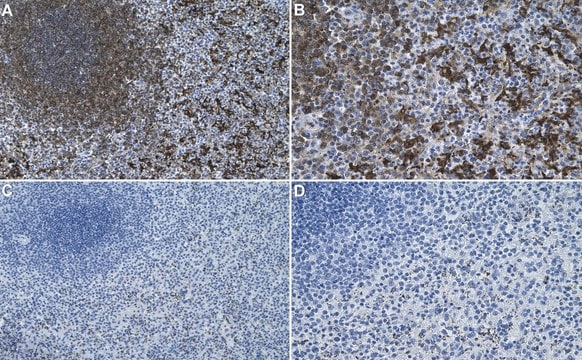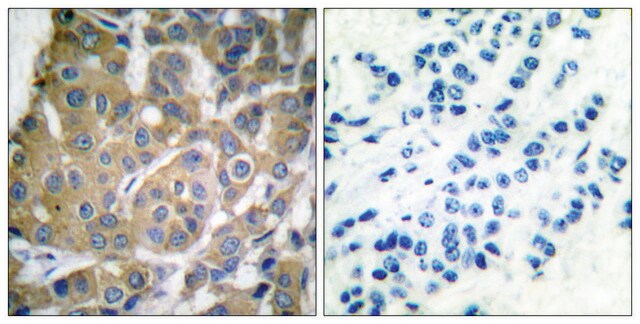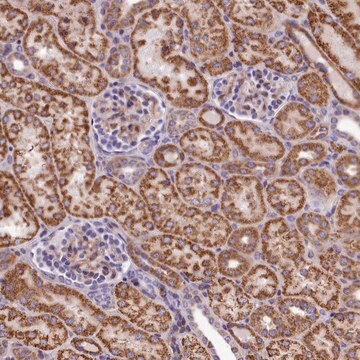일반 설명
We are committed to bringing you greener alternative products, which adhere to one or more of The 12 Principles of Green Chemistry.This antibody is Preservative-free, produced without the harm or sacrifice of animals and exceptionally stable to allow for ambient shipping and storage if needed and thus aligns with "Waste Prevention", "Designing Safer Chemicals" and "Design for Energy Efficiency".
Click here for more information.
ZooMAb® antibodies represent an entirely new generation of recombinant monoclonal antibodies. Each ZooMAb® antibody is manufactured using our proprietary recombinant expression system, purified to homogeneity, and precisely dispensed to produce robust and highly reproducible lot-to-lot consistency. Only top-performing clones are released for use by researchers. Each antibody is validated for high specificity and affinity across multiple applications, including its most commonly used application. ZooMAb® antibodies are reliably available and ready to ship when you need them.
특이성
Clone 1F17 is a ZooMAb® rabbit recombinant monoclonal antibody that specifically detects Fas/CD95. It targets an epitope within 18 amino acids from the cytoplasmic domain in the C-terminal region.
면역원
KLH-conjugated linear peptide corresponding to 18 amino acids from the C-terminal region of human Fas/CD95.
애플리케이션
Quality Control Testing
Evaluated by Western Blotting in HT-1080 cell lysate.
Western Blotting Analysis: A 1:1,000 dilution of this antibody detected Fas/CD95 in HT-1080 cell lysate.
Tested Applications
Western Blotting Analysis: A 1:1,000 dilution from a representative lot detected Fas/CD95 in Jurkat cell lysate.
Immunocytochemistry Analysis: A 1:100 dilution from a representative lot detected Fas/CD95 in Jurkat cells.
Affinity Binding Assay: A representative lot of this antibody bound Fas-CD95 peptide with a KD of 1.0 x 10-12 in an affinity binding assay.
Flow Cytometry Analysis: 0.1 µg from a representative lot detected Fas/CD95 in one million Raji and Jurkat cells.
Immunohistochemistry (Paraffin) Analysis: A 1:100 dilution from a representative lot detected Fas/CD95 in Human colon tissue sections.
Note: Actual optimal working dilutions must be determined by end user as specimens, and experimental conditions may vary with the end user.
표적 설명
Tumor necrosis factor receptor superfamily member 6 (UniProt: P25445; also known as Apo-1 antigen, Apoptosis-mediating surface antigen FAS, FASLG receptor, CD95) is encoded by the FAS (also known as APT1, FAS1, TNFRSF6) gene (Gene ID: 355) in human. The interaction of Fas with its ligand FasL (FasL/CD95L) regulates numerous physiological and pathological processes that are mediated through extrinsic apoptotic cell death. It is critical for the maintenance of immune tolerance. Seven isoforms of Fas have been described that are produced by alternative splicing. Isoform 1 is a single-pass type I membrane protein that is synthesized with a signal peptide (aa 1-25), which is subsequently cleaved off to produce the mature form that contains an extracellular domain (aa 26-173), a transmembrane domain (aa 174-190), and a cytoplasmic domain (aa 191-335). Isoforms 2 to 6 are secreted forms and isoform 7 is a dominant negative isoform that is resistant to Fas-mediated apoptosis. Isoforms 1 and 6 are expressed at equal levels in resting peripheral blood mononuclear cells; however, after activation there is an increase in isoform 1 and decrease in the levels of isoform 6. The binding of FasL to Fas drives Fas clustering and binding to FADD. Death domain of Fas that is localized in amino acids 230-314 is involved in its binding to FADD. FADD then recruits caspase-8 to form the death-inducing signaling complex (DISC) that is activated by specific post-translational modifications of the death receptor (DR), such as palmitoylation and O-linked glycosylation. The DISC mediates autocatalytic processing and activation of caspase-8, which propagate the death signal through proteolysis of effector other caspases such as caspases-3, 6, and 7. Mutations in FAS gene have been linked to autoimmune lymphoproliferative syndrome 1A that manifests in early childhood and results in the accumulation of autoreactive lymphocytes, which is characterized by non-malignant lymphadenopathy with hepatosplenomegaly, autoimmune hemolytic anemia, thrombocytopenia, and neutropenia. This ZooMAb® recombinant monoclonal antibody, generated by our propriety technology, offers significantly enhanced specificity, Affinity™, reproducibility, and stability over conventional monoclonals. (Ref.: Yamada, A., et al. (2017). Front. Immunol. 8; 403; Scott, FL., et al. (2009). Nature. 457(7232); 1019-1022).
물리적 형태
Purified recombinant rabbit monoclonal antibody IgG, lyophilized in PBS with 5% Trehalose, normal appearance a coarse or translucent resin. The PBS/trehalose components in the ZooMAb formulation can have the appearance of a semi-solid (bead like gel) after lyophilization. This is a normal phenomenon. Please follow the recommended reconstitution procedure in the data sheet to dissolve the semi-solid, bead-like, gel-appearing material. The resulting antibody solution is completely stable and functional as proven by full functional testing. Contains no biocide or preservatives, such as azide, or any animal by-products. Larger pack sizes provided as multiples of 25 µL.
재구성
300 µg/mL after reconstitution at 25 µL per vial. Please refer to guidance on suggested starting dilutions and/or titers per application and sample type.
저장 및 안정성
Recommend storage of lyophilized product at 2-8°C; Before reconstitution, micro-centrifuge vials briefly to spin down material to bottom of the vial; Reconstitute each vial by adding 25 µL of filtered lab grade water or PBS; Reconstituted antibodies can be stored at 2-8°C, or -20°C for long term storage. Avoid repeated freeze-thaws.
기타 정보
Concentration: Please refer to the Certificate of Analysis for the lot-specific concentration.
법적 정보
Affinity is a trademark of Mine Safety Appliances Co.
ZooMAb is a registered trademark of Merck KGaA, Darmstadt, Germany
면책조항
Unless otherwise stated in our catalog or other company documentation accompanying the product(s), our products are intended for research use only and are not to be used for any other purpose, which includes but is not limited to, unauthorized commercial uses, in vitro diagnostic uses, ex vivo or in vivo therapeutic uses or any type of consumption or application to humans or animals.



